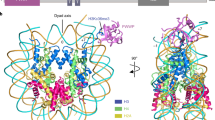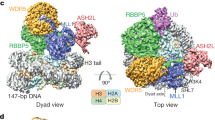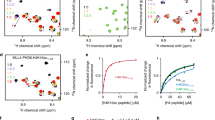Abstract
WDR5 is a core component of SET1-family complexes that achieve transcriptional activation via methylation of histone H3 on Nζ of Lys4 (H3K4). The role of WDR5 in the MLL1 complex has recently been described as specific recognition of dimethyl-K4 in the context of a histone H3 amino terminus; WDR5 is essential for vertebrate development, Hox gene activation and global H3K4 trimethylation. We report the high-resolution X-ray structures of WDR5 in the unliganded form and complexed with histone H3 peptides having unmodified and mono-, di- and trimethylated K4, which together provide the first comprehensive analysis of methylated histone recognition by the ubiquitous WD40-repeat fold. Contrary to predictions, the structures reveal that WDR5 does not read out the methylation state of K4 directly, but instead serves to present the K4 side chain for further methylation by SET1-family complexes.
This is a preview of subscription content, access via your institution
Access options
Subscribe to this journal
Receive 12 print issues and online access
$189.00 per year
only $15.75 per issue
Buy this article
- Purchase on Springer Link
- Instant access to full article PDF
Prices may be subject to local taxes which are calculated during checkout





Similar content being viewed by others
References
Wang, Y. et al. Linking covalent histone modifications to epigenetics: the rigidity and plasticity of the marks. Cold Spring Harb. Symp. Quant. Biol. 69, 161–169 (2004).
Jenuwein, T. & Allis, C.D. Translating the histone code. Science 293, 1074–1080 (2001).
Strahl, B.D. & Allis, C.D. The language of covalent histone modifications. Nature 403, 41–45 (2000).
Bernstein, B.E. et al. Genomic maps and comparative analysis of histone modifications in human and mouse. Cell 120, 169–181 (2005).
Lachner, M., O'Carroll, D., Rea, S., Mechtler, K. & Jenuwein, T. Methylation of histone H3 lysine 9 creates a binding site for HP1 proteins. Nature 410, 116–120 (2001).
Peters, A.H. et al. Loss of the Suv39h histone methyltransferases impairs mammalian heterochromatin and genome stability. Cell 107, 323–337 (2001).
Santos-Rosa, H. et al. Active genes are tri-methylated at K4 of histone H3. Nature 419, 407–411 (2002).
Cao, R. et al. Role of histone H3 lysine 27 methylation in Polycomb-group silencing. Science 298, 1039–1043 (2002).
Bernstein, B.E. et al. Methylation of histone H3 Lys 4 in coding regions of active genes. Proc. Natl. Acad. Sci. USA 99, 8695–8700 (2002).
Briggs, S.D. et al. Histone H3 lysine 4 methylation is mediated by Set1 and required for cell growth and rDNA silencing in Saccharomyces cerevisiae. Genes Dev. 15, 3286–3295 (2001).
Miller, T. et al. COMPASS: a complex of proteins associated with a trithorax-related SET domain protein. Proc. Natl. Acad. Sci. USA 98, 12902–12907 (2001).
Milne, T.A. et al. MLL targets SET domain methyltransferase activity to Hox gene promoters. Mol. Cell 10, 1107–1117 (2002).
Nagy, P.L., Griesenbeck, J., Kornberg, R.D. & Cleary, M.L. A trithorax-group complex purified from Saccharomyces cerevisiae is required for methylation of histone H3. Proc. Natl. Acad. Sci. USA 99, 90–94 (2002).
Nakamura, T. et al. ALL-1 is a histone methyltransferase that assembles a supercomplex of proteins involved in transcriptional regulation. Mol. Cell 10, 1119–1128 (2002).
Roguev, A. et al. The Saccharomyces cerevisiae Set1 complex includes an Ash2 homologue and methylates histone 3 lysine 4. EMBO J. 20, 7137–7148 (2001).
Schneider, R., Bannister, A.J. & Kouzarides, T. Unsafe SETs: histone lysine methyltransferases and cancer. Trends Biochem. Sci. 27, 396–402 (2002).
Hess, J.L. MLL: a histone methyltransferase disrupted in leukemia. Trends Mol. Med. 10, 500–507 (2004).
Hughes, C.M. et al. Menin associates with a trithorax family histone methyltransferase complex and with the hoxc8 locus. Mol. Cell 13, 587–597 (2004).
Wysocka, J. et al. WDR5 associates with histone H3 methylated at K4 and is essential for H3 K4 methylation and vertebrate development. Cell 121, 859–872 (2005).
Yu, B.D., Hess, J.L., Horning, S.E., Brown, G.A. & Korsmeyer, S.J. Altered Hox expression and segmental identity in Mll-mutant mice. Nature 378, 505–508 (1995).
Terranova, R., Agherbi, H., Boned, A., Meresse, S. & Djabali, M. Histone and DNA methylation defects at Hox genes in mice expressing a SET domain-truncated form of Mll. Proc. Natl. Acad. Sci. USA 103, 6629–6634 (2006).
Han, Z. et al. Structural basis for the specific recognition of methylated histone H3 lysine 4 by the WD-40 protein WDR5. Mol. Cell 22, 137–144 (2006).
Sprague, E.R., Redd, M.J., Johnson, A.D. & Wolberger, C. Structure of the C-terminal domain of Tup1, a corepressor of transcription in yeast. EMBO J. 19, 3016–3027 (2000).
Henderson, R. Structure of crystalline alpha-chymotrypsin. IV. The structure of indoleacryloyl-alpha-chyotrypsin and its relevance to the hydrolytic mechanism of the enzyme. J. Mol. Biol. 54, 341–354 (1970).
Li et al. Molecular basis for site-specific read-out of histone H3K4me3 by the BPTF PHD finger of NURF. Nature advance online publication 21 May 2006.
Huang, Y., Fang, J., Bedford, M.T., Zhang, Y. & Xu, R.M. Recognition of histone H3 lysine-4 methylation by the double tudor domain of JMJD2A. Science 312, 748–751 (2006).
Flanagan, J.F. et al. Double chromodomains cooperate to recognize the methylated histone H3 tail. Nature 438, 1181–1185 (2005).
Jacobs, S.A. & Khorasanizadeh, S. Structure of HP1 chromodomain bound to a lysine 9-methylated histone H3 tail. Science 295, 2080–2083 (2002).
Zhang, X. et al. Structural basis for the product specificity of histone lysine methyltransferases. Mol. Cell 12, 177–185 (2003).
Xiao, B. et al. Structure and catalytic mechanism of the human histone methyltransferase SET7/9. Nature 421, 652–656 (2003).
Scheiner, S., Kar, T. & Gu, Y. Strength of the Calpha H.O hydrogen bond of amino acid residues. J. Biol. Chem. 276, 9832–9837 (2001).
Case, D.A. et al. The Amber biomolecular simulation programs. J. Comput. Chem. 26, 1668–1688 (2005).
Dou, Y. et al. Regulation of MLL1 H3K4 methyltransferase activity by its core components. Nat. Struct. Mol. Biol. (in the press).
Chin, H.G., Patnaik, D., Esteve, P.O., Jacobsen, S.E. & Pradhan, S. Catalytic properties and kinetic mechanism of human recombinant Lys-9 histone H3 methyltransferase SUV39H1: participation of the chromodomain in enzymatic catalysis. Biochemistry 45, 3272–3284 (2006).
Hu, P. & Zhang, Y. Catalytic mechanism and product specificity of the histone lysine methyltransferase SET7/9: an ab initio QM/MM-FE study with multiple initial structures. J. Am. Chem. Soc. 128, 1272–1278 (2006).
Rea, S. et al. Regulation of chromatin structure by site-specific histone H3 methyltransferases. Nature 406, 593–599 (2000).
Milne, T.A. et al. MLL associates specifically with a subset of transcriptionally active target genes. Proc. Natl. Acad. Sci. USA 102, 14765–14770 (2005).
Cao, R. & Zhang, Y. SUZ12 is required for both the histone methyltransferase activity and the silencing function of the EED-EZH2 complex. Mol. Cell 15, 57–67 (2004).
Verreault, A., Kaufman, P.D., Kobayashi, R. & Stillman, B. Nucleosomal DNA regulates the core-histone-binding subunit of the human Hat1 acetyltransferase. Curr. Biol. 8, 96–108 (1998).
Chen, G. & Courey, A.J. Groucho/TLE family proteins and transcriptional repression. Gene 249, 1–16 (2000).
Ahmad, A., Takami, Y. & Nakayama, T. WD dipeptide motifs and LXXLL motif of chicken HIRA are essential for interactions with the p48 subunit of chromatin assembly factor-1 and histone deacetylase-2 in vitro and in vivo. Gene 342, 125–136 (2004).
Vagin, A. & Teplyakov, A. MOLREP: an automated program for molecular replacement. J. Appl. Crystallogr. 30, 1022–1025 (1997).
Read, R.J. Pushing the boundaries of molecular replacement with maximum likelihood. Acta Crystallogr. D Biol. Crystallogr. 57, 1373–1382 (2001).
Collaborative Computational Project. Number 4. The CCP4 Suite: programs for protein crystallography. Acta Crystallogr. D Biol. Crystallogr. 50, 760–763 (1994).
Morris, R.J. et al. Breaking good resolutions with ARP/wARP. J. Synchrotron Radiat. 11, 56–59 (2004).
Brunger, A.T. et al. Crystallography & NMR system: a new software suite for macromolecular structure determination. Acta Crystallogr. D Biol. Crystallogr. 54, 905–921 (1998).
Emsley, P. & Cowtan, K. Coot: model-building tools for molecular graphics. Acta Crystallogr. D Biol. Crystallogr. 60, 2126–2132 (2004).
Murshudov, G.N., Vagin, A.A. & Dodson, E.J. Refinement of macromolecular structures by the maximum-likelihood method. Acta Crystallogr. D Biol. Crystallogr. 53, 240–255 (1997).
Winn, M.D., Isupov, M.N. & Murshudov, G.N. Use of TLS parameters to model anisotropic displacements in macromolecular refinement. Acta Crystallogr. D Biol. Crystallogr. 57, 122–133 (2001).
Schuttelkopf, A.W. & van Aalten, D.M. PRODRG: a tool for high-throughput crystallography of protein-ligand complexes. Acta Crystallogr. D Biol. Crystallogr. 60, 1355–1363 (2004).
Laskowski, R.J., Macarthur, M.W., Moss, D.S. & Thornton, J.M. PROCHECK: a program to check the stereochemical quality of protein structures. J. Appl. Crystallogr. 26, 283–290 (1993).
Baker, N.A., Sept, D., Joseph, S., Holst, M.J. & McCammon, J.A. Electrostatics of nanosystems: application to microtubules and the ribosome. Proc. Natl. Acad. Sci. USA 98, 10037–10041 (2001).
Acknowledgements
We are grateful to the staff of National Synchrotron Light Source (NSLS) beamline X-29, in particular W. Shi and H. Robinson, as well as the staff of Advanced Light Source beamline 5.02, especially C. Trame, and the staff of Advanced Photon Source (APS) beamline 24-ID, importantly I. Kourinov and K. Rajashankar, for assistance in X-ray data collection. Financial support for NSLS px group beamlines comes principally from the Offices of Biological and Environmental Research and of Basic Energy Sciences of the US Department of Energy and from the National Center for Research Resources of the US National Institutes of Health (NIH). This work is based upon research conducted at the Northeastern Collaborative Access Team beamlines of the APS, which is supported by the National Center for Research Resources at the NIH. We thank the Dana Farber Cancer Research Center, F. Bernal and L. Walensky for amino acid analysis and peptide synthesis advice; S.S. Yi (Memorial Sloan-Kettering Cancer Center) for synthesis of H3K4me2 complex II and the unmodified peptides, the Dana Farber Cancer Research Center and the Harvard Center for Genomics Research for use of their Biacore instruments, and F. Bernal, Y. Dou, K. Herlihy, Y. Inuzuka, D. Pakotiprapha, T.A. Milne, R.G. Roeder, S.D. Taverna and J. Wysocka for valuable discussions and scientific input. This work was supported by an NIH grant to G.L.V.; D.J.P. is supported by funds from the Abby Rockefeller Mauze Trust and the Dewitt Wallace and Maloris Foundations; and C.D.A. is supported by an NIH MERIT award and funds from Rockefeller University.
Author information
Authors and Affiliations
Contributions
A.J.R. is responsible for the X-ray studies of the apo structure and the H3K4me1, H3K4me2 and H3K4me3 structures, W.-K.W. and H.L. are responsible for the unmodified peptide structure and an additional H3K4me2 structure (complex II), and D.M.G. performed the binding studies with some assistance from A.J.R. and W.-K.W. G.L.V., D.J.P. and C.D.A. supervised the structural and biochemical aspects of the project and take overall responsibility for their joint research. All authors discussed the results and commented on the manuscript.
Corresponding author
Ethics declarations
Competing interests
The authors declare no competing financial interests.
Supplementary information
Supplementary Fig. 1
Superpositions of WDR5 structures. (PDF 1218 kb)
Supplementary Fig. 2
Stereo view of Arg2 and Lys4 electron density. (PDF 560 kb)
Supplementary Fig. 3
Fluorescence anisotropy measurment of peptide binding to WDR5 (Y191F). (PDF 83 kb)
Rights and permissions
About this article
Cite this article
Ruthenburg, A., Wang, W., Graybosch, D. et al. Histone H3 recognition and presentation by the WDR5 module of the MLL1 complex. Nat Struct Mol Biol 13, 704–712 (2006). https://doi.org/10.1038/nsmb1119
Received:
Accepted:
Published:
Issue Date:
DOI: https://doi.org/10.1038/nsmb1119
This article is cited by
-
Wdr5-mediated H3K4me3 coordinately regulates cell differentiation, proliferation termination, and survival in digestive organogenesis
Cell Death Discovery (2023)
-
A novel variant in TLE6 is associated with embryonic developmental arrest (EDA) in familial female infertility
Scientific Reports (2022)
-
FOXQ1 recruits the MLL complex to activate transcription of EMT and promote breast cancer metastasis
Nature Communications (2022)
-
Rescue of deficits by Brwd1 copy number restoration in the Ts65Dn mouse model of Down syndrome
Nature Communications (2022)
-
MasterPATH: network analysis of functional genomics screening data
BMC Genomics (2020)



